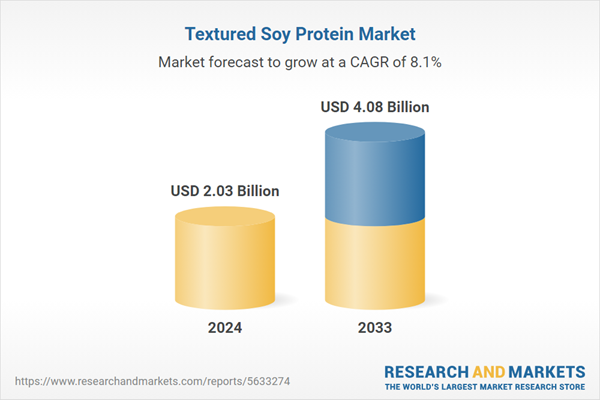Textured soy protein is processed from defatted soy flour mixture and used as a meat extender or substitute in tacos, meatloaf, chili, sloppy joes, and seafood. It can also be utilized for adding a unique texture and mild flavor to commercially made vegetarian and vegan food products, such as sauces, plant-based chili mixes, and veggie burgers. It is low in calories and contains several essential nutrients, including fiber, copper, folate, magnesium, and thiamin. It is also rich in folate, which is a water-soluble vitamin that assists in producing deoxyribonucleic acid (DNA) in the body. Presently, textured soy protein is widely available in flavored and unflavored varieties and different sizes, from large chunks to small flakes.
Textured Soy Protein Market Trends:
Textured soy protein offers numerous health benefits, such as tissue repair, wound healing, muscle growth, and reducing cholesterol and triglyceride levels. The rising awareness among individuals about these benefits, along with a considerable shift in consumer preference towards vegetarian and vegan diets, represents one of the key factors increasing the consumption of textured soy protein worldwide. This is further supported by the rising health consciousness among the masses and the growing uptake of meat substitutes. Besides this, it is added to healthy bars, salads, cereals, baked potatoes, and stuffing as a protein additive. This, in confluence with the escalating demand for protein-based recipes on account of the emerging fitness culture, is contributing to the market growth. Apart from this, manufacturers are introducing non-genetically modified organisms (non-GMO) and gluten-free variants in various shapes, colors, and textures to cater to diversified customer needs. As these products are readily available through online channels, the thriving e-commerce industry is anticipated to drive the market.Market Segmentation:
This report provides an analysis of the key trends in each segment of the global textured soy protein market, along with forecast at the global, regional, and country levels from 2025-2033. The market has been categorized based on nature, source, and application.Breakup by Nature:
- Organic
- Conventional
- Non-GMO
Breakup by Source:
- Soy Protein Concentrates
- Soy Protein Isolates
- Soy Flour
Breakup by Application:
- Food
- Feed
Breakup by Region:
- North America
- United States
- Canada
- Asia-Pacific
- China
- Japan
- India
- South Korea
- Australia
- Indonesia
- Others
- Europe
- Germany
- France
- United Kingdom
- Italy
- Spain
- Russia
- Others
- Latin America
- Brazil
- Mexico
- Others
- Middle East and Africa
Competitive Landscape:
The competitive landscape of the industry has also been examined along with the profiles of the key players being Archer-Daniels-Midland Company, Bob's Red Mill Natural Foods, Bunge Limited, Cargill Incorporated, CHS Inc., Crown Soya Protein Group Company, International Flavors & Fragrances Inc., Fuji Oil Holdings Inc., Shandong Yuxin Biotechnology Co. Ltd., Sonic Biochem Extraction Pvt Ltd and Wilmar International Limited.Key Questions Answered in This Report
1. How big is the textured soy protein market?2. What is the future outlook of textured soy protein market?
3. What are the key factors driving the textured soy protein market?
4. Which region accounts for the largest textured soy protein market share?
5. Which are the leading companies in the global textured soy protein market?
Table of Contents
Companies Mentioned
- Archer-Daniels-Midland Company
- Bob's Red Mill Natural Foods
- Bunge Limited
- Cargill Incorporated
- CHS Inc.
- Crown Soya Protein Group Company
- International Flavors & Fragrances Inc.
- Fuji Oil Holdings Inc.
- Shandong Yuxin Biotechnology Co. Ltd.
- Sonic Biochem Extraction Pvt Ltd
- Wilmar International Limited
Table Information
| Report Attribute | Details |
|---|---|
| No. of Pages | 141 |
| Published | May 2025 |
| Forecast Period | 2024 - 2033 |
| Estimated Market Value ( USD | $ 2.03 Billion |
| Forecasted Market Value ( USD | $ 4.08 Billion |
| Compound Annual Growth Rate | 8.1% |
| Regions Covered | Global |
| No. of Companies Mentioned | 11 |









